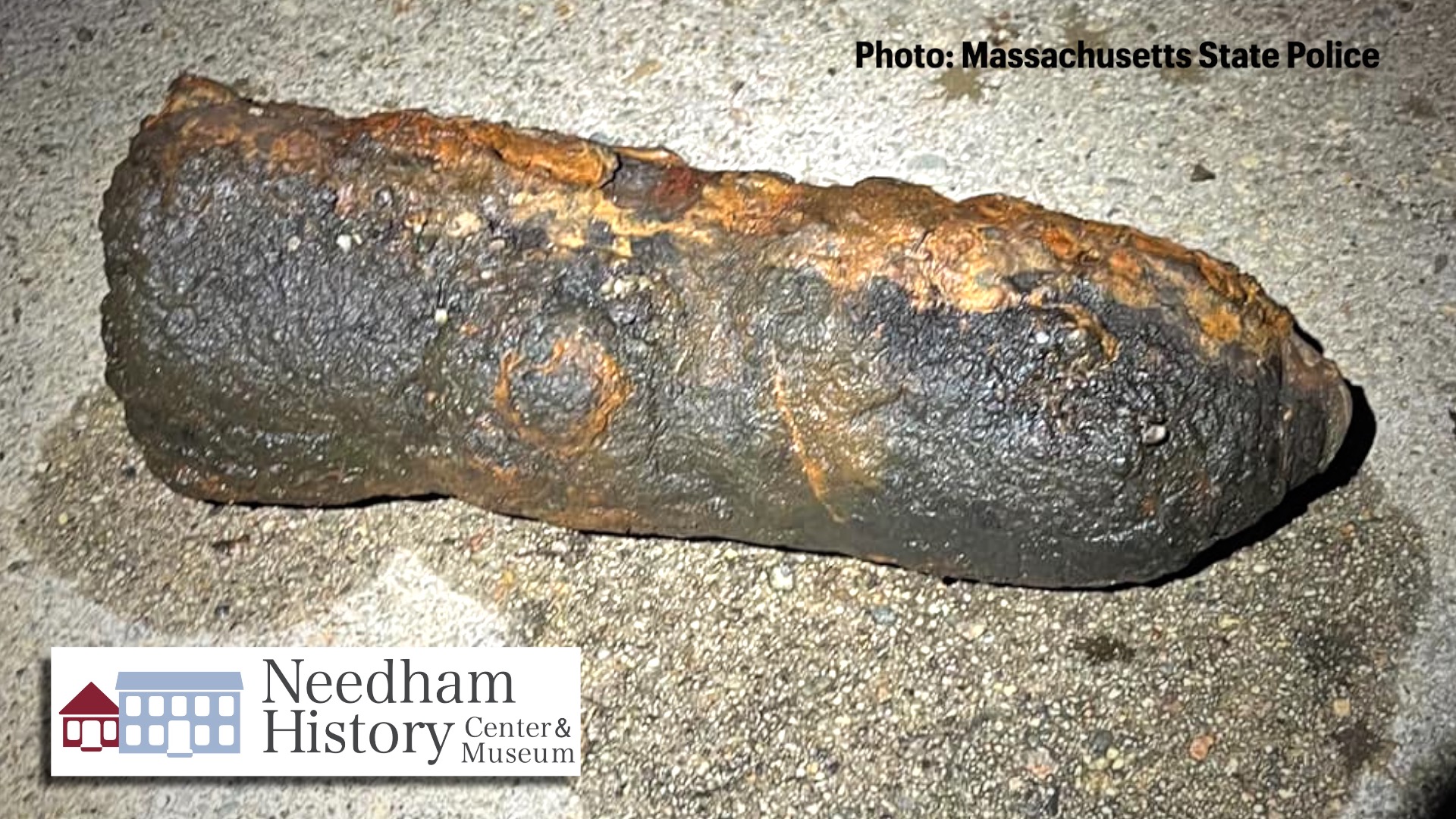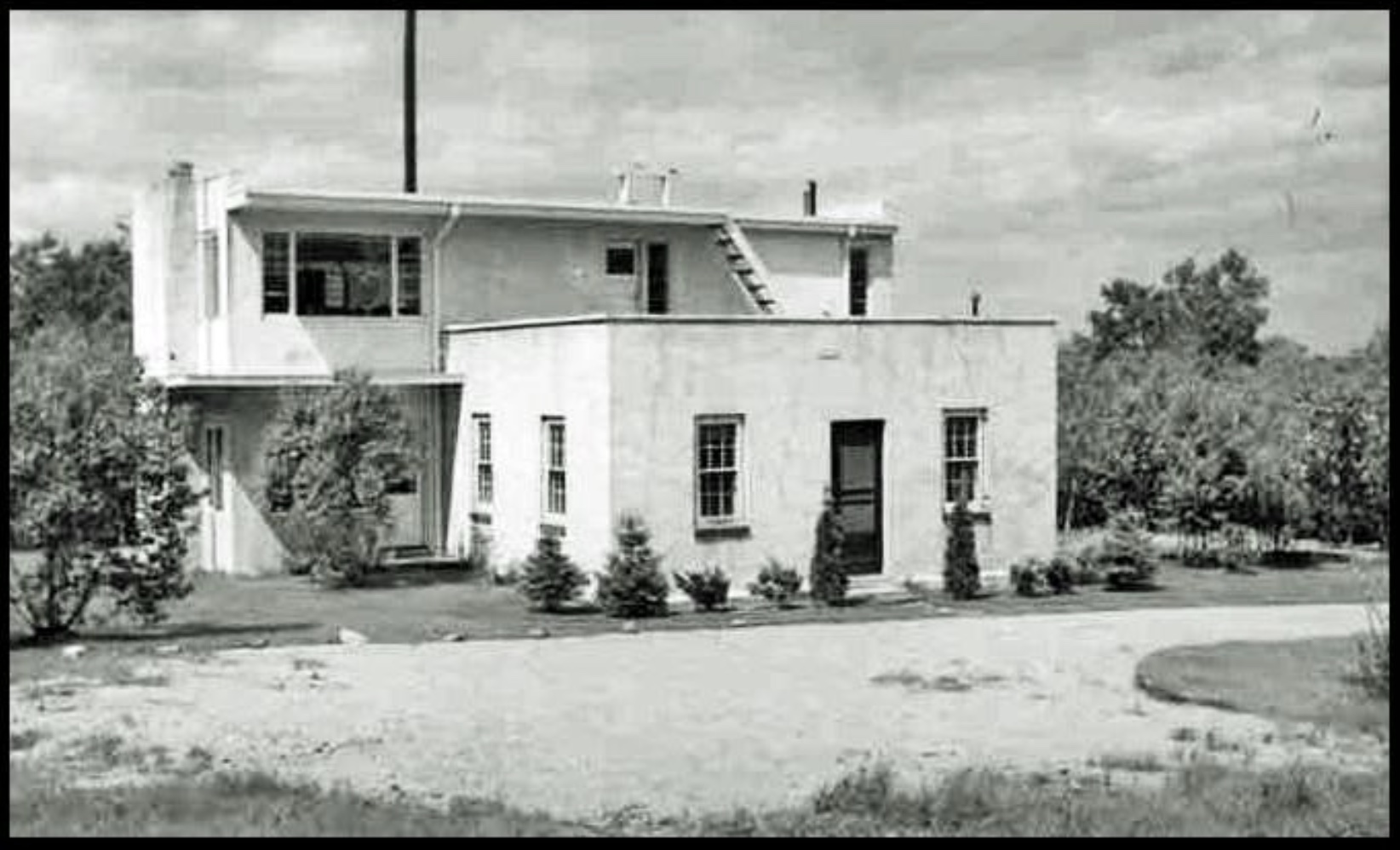
Needham History: About Those Bombs…
Maybe bringing explosives home to the suburbs was not such a good idea after all…

The Cosmic-Terrestrial Research Laboratory at 31 Bird Street, circa 1942. The small section in front is the former Press Wireless Corporation building, and the two story addition to the back housed the offices and labs. The ladders provided access to the roof- top equipment, and to the recreational sun deck.
About Those Bombs…
or, Two Stories that Explain Everything, and Nothing
I think it is fair to say that we were all pretty surprised when a magnet fisherman pulled an old mortar shell out of the Charles River near Kendrick Bridge two weeks ago. I think I can also say that we were pretty shocked when a second shell – this time a bazooka round – was pulled from the same location a few days later.
The question, then, was obvious, and all of the news services were asking it – where did these shells come from? It is well-known that Needham had a military installation in the 1950s, so the ordnance must have come from there, right?
Actually, wrong.
It is in fact true that Needham once hosted a military installation. From about 1951 to 1963, Needham was the site of a Nike (surface-to-air) missile battery. The Nike site, on Pine Street, was one of several such installations that protected the military research sites in Natick, Watertown, and Cambridge during the early days of the Cold War. This was dangerous and (for its day) high-tech weaponry; it was carefully monitored, and no one was dumping it into the river.
The shells found in the Charles were from earlier wars – World War II for the bazooka shell, and WW2 or possibly earlier for the mortar shell. There were no military installations of that period in the Needham area. The closest, as confirmed by the Army Corps of Engineers, New England District, was in Watertown, and these materials did not come from there either. (Thank you, Needham Observer, for this information!) The most likely scenario is that someone brought these home as souvenirs after his war service, and then came to realize that a suburban house with the wife and kids might not be the best place to keep large explosives. So over the rail and into the river they went.
I had a second request for information this week about a possible military site (an ammo dump?) in Birds Hill. Birds Hill has been residential since the 1700s (the John Bird House on Beaufort Avenue was built in 1755), and has been the site of a school, a train station, the water lands (aquifers) for Needham, Newton and Brookline, and other features that would make an ammo dump quite unlikely. There was, however, a site in the neighborhood that did carry out military research – the former Cosmic-Terrestrial Research Lab on Bird Street. CTRL started as a radio reception site, and later became a lab to study the effects of solar activity and other atmospheric interference on the transmission of long-distance radio signals. This was of vital importance during the Second World War, and later as the military and civil aviation industries grew.
Both of these are good stories, so I have linked them here so you can read them in their entirety. Enjoy!
Nike Missile Defense:
Needham Was Ready to Take On the Soviets … Almost.
Following the Second World War, the main threat to US security came from our former ally, the Soviet Union. Apart from their expansion into Europe, it became clear by 1947 that the Soviets had bombers that could range well into US territory; this necessitated a new deployment of anti-aircraft defenses, this time to defend our own borders.,/p>
The first anti-aircraft installation in Needham was built in 1951, on the corner of Gould St. and Highland Avenue, now a part of Muzi Ford’s lot. Needham was one of eleven batteries that formed a defensive ring around Boston and Cambridge, and the defense-research installations that were located there. The weapons deployed here were not missiles yet, but 120mm guns, with a radar-controlled guidance system. Unfortunately – and unknown to the public – the guidance system did not actually work. Finish the Story…
The Cosmic-Terrestrial Research Lab:
Can You Hear Us Now?
It sounds like a story out of a bad science fiction movie—scientists hunkered down on an isolated hilltop in the country, listening to signals from space. Were they hoping to make contact with aliens, or just to warn us of their approach?
Mostly, they just wanted to hear better, whoever was doing the talking.
The story begins in 1929, with the formation of the Press Wireless Corporation, known as “PreWi.” PreWi was formed as a public utility (to have access to the radio band) by a consortium of the big press companies of the day – the New York Times Company, the Chicago Daily News, AP, King Features, etc. Its purpose was to create a reliable channel for trans-oceanic radio communications for news gathering. They built their first receiver station in Needham, on Bird Street just past its intersection with Greendale Ave. The elevated location and clear reception field made the Birds Hill site ideal for its job of receiving transmissions from London, via Halifax, Nova Scotia. The Needham installation lasted for only a few years, and the operations moved elsewhere as PreWi expanded and built new transmission stations to handle nation-wide and trans-Pacific signals.
In 1935, MIT received grants from the American Philosophical Society, the Naval Research Laboratory, and the National Bureau of Standards for “investigations in cosmic-terrestrial relationships” – or, more precisely, “the diurnal, annual, and other periodic fluctuations in field-strengths of radio-wave propagation, the study of the distribution of ions at the earth’s surface, the study of solar effects on the transmission of time-signals propagated by radio, and variations in the quantity and quality of transmitted sunlight.” In English, their goal was to study the effects of atmospheric electricity and the actions of the sun, moon, and other elements on the transmission of radio waves. Finish the Story…
 |
Gloria Polizzotti Greis is the Executive Director of the Needham History Center & Museum. For more information, please see their website at www.needhamhistory.org. |

